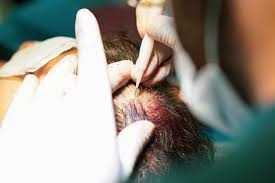Hair loss can be a challenging experience, but advances in medical technology have made hair transplants an effective solution for many individuals seeking to restore their hair and confidence. If you’re considering a hair transplant in Riyadh, understanding what to expect during the procedure can help alleviate anxiety and prepare you for a successful experience. This article will walk you through the entire process, from the initial consultation to post-operative care, providing a comprehensive overview of what to expect during Hair Transplant in Riyadh.
1. Initial Consultation
The journey to hair restoration begins with an initial consultation at your chosen clinic. This meeting is crucial for assessing your hair loss, discussing your goals, and determining the most suitable treatment plan. During this consultation:
- Assessment of Hair Loss:
The surgeon will evaluate your hair loss pattern, scalp condition, and medical history to identify the most appropriate technique for your needs. - Discussion of Goals:
You’ll have the opportunity to express your expectations and desired outcomes, allowing the surgeon to tailor the procedure to your unique situation. - Explanation of Procedures:
The surgeon will explain the various hair transplant techniques available (e.g., Follicular Unit Extraction (FUE) and Follicular Unit Transplantation (FUT)), outlining their benefits and potential risks. - Cost and Financing Options:
You will receive a detailed breakdown of costs, including any financing options if needed. Understanding the financial aspect is crucial for making informed decisions.
2. Preparation for the Procedure
Once you’ve decided to move forward with the transplant, the clinic will provide specific pre-operative instructions to ensure a smooth experience:
- Avoid Certain Medications:
You may be advised to avoid blood thinners and certain supplements that could increase the risk of bleeding. - Maintain Scalp Hygiene:
Keeping your scalp clean in the days leading up to the procedure is essential for minimizing the risk of infection. - Arrangements for Transportation:
Since you may receive sedation during the procedure, arrange for someone to drive you home afterward.
3. The Hair Transplant Procedure
On the day of the procedure, here’s what you can generally expect:
Arrival at the Clinic
- Check-In:
Upon arrival, you’ll check in and be greeted by the clinic staff, who will ensure you’re prepared for the procedure. - Medical Evaluation:
The medical team may conduct a final assessment to confirm your eligibility for the procedure and address any last-minute questions or concerns.
Anesthesia Administration
- Local Anesthesia:
The surgeon will administer local anesthesia to numb the donor and recipient areas of your scalp. This ensures that you remain comfortable throughout the procedure. - Sedation Options:
Some clinics may offer mild sedation to help you relax, especially if you feel anxious about the procedure.
Hair Follicle Extraction
Depending on the chosen technique, the extraction process will vary:
- Follicular Unit Extraction (FUE):
Individual hair follicles are harvested from the donor area (usually the back of the head) using a specialized device. This method leaves minimal scarring and allows for faster recovery. - Follicular Unit Transplantation (FUT):
A strip of scalp is removed from the donor area, and the follicles are then carefully dissected and prepared for transplantation. This method may leave a linear scar but can be more cost-effective for larger transplants.
Graft Implantation
- Recipient Site Preparation:
The surgeon will create tiny incisions in the recipient area, where the harvested follicles will be implanted. - Graft Placement:
The technician will then carefully place the grafts into the prepared sites, following the natural hair growth pattern to ensure a natural-looking result.
4. Duration of the Procedure
The duration of a hair transplant procedure can vary based on the number of grafts being transplanted and the technique used. On average, the procedure may take anywhere from 4 to 8 hours. During this time, you may listen to music, watch TV, or even take short breaks as needed.
5. Post-Operative Care
After the procedure, the clinic will provide you with detailed aftercare instructions to promote optimal healing and results:
- Initial Recovery:
You may experience mild swelling, redness, and discomfort in the treated areas. This is normal and should subside within a few days. - Avoiding Strenuous Activities:
Refrain from heavy exercise and physical activities for at least a week to allow your scalp to heal. - Washing and Caring for Your Scalp:
Follow the specific instructions provided for washing your hair and caring for the transplant area. Avoid rubbing or scratching the scalp during the initial healing phase. - Medications:
You may be prescribed medications to manage discomfort and prevent infection. Be sure to take them as directed.
6. Follow-Up Appointments
Regular follow-up appointments with your surgeon are essential for monitoring your recovery and assessing the growth of your newly transplanted hair. During these visits, your surgeon can address any concerns, provide additional care recommendations, and celebrate your progress.
Conclusion
Understanding what to expect during hair transplant procedures in Riyadh can help ease your anxiety and prepare you for a successful experience. From the initial consultation to the post-operative care phase, being informed about each step of the process is key to achieving optimal results. With the right clinic and skilled professionals, you can look forward to the transformative benefits of hair restoration, reclaiming your confidence and enhancing your overall quality of life. If you’re considering a hair transplant, don’t hesitate to reach out to reputable clinics in Riyadh to begin your journey toward a fuller head of hair.
